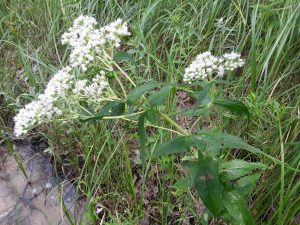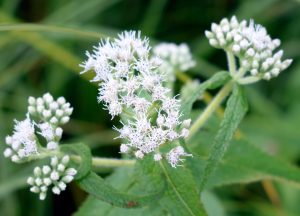Common Boneset

Eupatorium perfoliatum is a flowering herb offering medicinal qualities that healers in N. America have used for millennia. The leaves and flowers are the parts generally used to make a bitter tea treating a host of ailments: antiviral for treating the common cold and flu, as a fever reducer, laxative, expectorant for bronchial symptoms, proven pain relief — and yes, as a folk remedy said to help in the mending of broken bones. Not bad to have some of that around!
 Native to Minnesota, boneset is in the Asteraceae (Aster) family. Blooming July into October, flowers grow on stalks in flat-topped, branching clusters (called umbels in botany). Looking closely, you’ll find each star-shaped, disk flower to have 5 petal-like lobes with a long, string-like, parted style emerging from the center. Flowers offer both pollen and nectar — a welcome source for pollinators looking for sustenance that time of year when fewer plants are blooming. In fall, a small black seed ripens with a tuft of hair to carry it off into the wind, and is a food beloved by goldfinches, juncos, and other seed-eating birds.
Native to Minnesota, boneset is in the Asteraceae (Aster) family. Blooming July into October, flowers grow on stalks in flat-topped, branching clusters (called umbels in botany). Looking closely, you’ll find each star-shaped, disk flower to have 5 petal-like lobes with a long, string-like, parted style emerging from the center. Flowers offer both pollen and nectar — a welcome source for pollinators looking for sustenance that time of year when fewer plants are blooming. In fall, a small black seed ripens with a tuft of hair to carry it off into the wind, and is a food beloved by goldfinches, juncos, and other seed-eating birds.
Boneset loves sunny, wet areas such as near the water of marshes or growing in the sandy soil along the waterline of lakeshores — depicted here near the swimming beach at Little Bass Lake. If you look closely, you will see that the wrinkled leaves of boneset typically join right around the hairy stem, appearing as if the stem is growing right up through one large leaf, sometimes in whorls of three. Look for common boneset flowers to appear about the same time and in similar habitat as blue lobelia, northern bugleweed and many other mid-to-late-summer bloomers.
